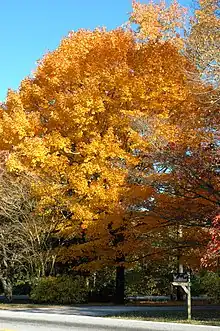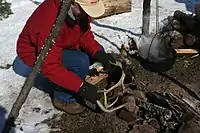Maple sugar
Maple sugar is a traditional sweetener in Canada and the northeastern United States, prepared from the sap of the maple tree ("maple sap").
 Ziiga'igaans (maple sugar cubes) being made in a ziiga'iganaatig (sugar press-mould) | |
| Type | Confectionery |
|---|---|
| Place of origin | Canada and the United States |
| Main ingredients | Sap of the sugar maple tree |

Sources

Three species of maple trees in the genus Acer are predominantly used to produce maple sugar: the sugar maple (A. saccharum), the black maple (A. nigrum), and the red maple (A. rubrum),[1] because of the high sugar content (roughly two to five percent) in the sap of these species.[2] The black maple is included as a subspecies or variety in a more broadly viewed concept of A. saccharum, the sugar maple, by some botanists.[3] Of these, the red maple has a shorter season because it buds earlier than sugar and black maples, which alters the flavor of the sap.[4]
A few other species of maple are also sometimes used as sources of sap for producing maple sugar, including the box elder (or Manitoba maple, A. negundo),[5] the silver maple (A. saccharinum),[6] and the bigleaf maple (A. macrophyllum).[7] Similar sugars may also be produced from birch or palm trees, among other sources.[8][9]
Preparation
Maple sugar is what remains after the sap of the sugar maple is boiled for longer than is needed to create maple syrup or maple taffy.[10] Once almost all the water has been boiled off, all that is left is a solid sugar.[10] By composition, this sugar is about 90% sucrose, the remainder consisting of variable amounts of glucose and fructose.[11] This is usually sold in pressed blocks or as a translucent candy. It is difficult to create as the sugar easily burns and thus requires considerable skill.[10]
Regulation for product labeling
In Canada, maple sugar is one of several maple products manufactured from maple sap or maple syrup, including maple butter and maple taffy.[12] Under the Food and Drugs Act and Consumer Packaging and Labelling Act, Canadian regulations require that maple sugar products identify the business identity and country of origin on the retail product label.[12]
History
Maple sugar was made by many First Nations/American Indian peoples. Unlike maple syrup, it was easy to transport and long lasting.[13] It is called ziinzibaakwad by the Anishinaabeg.[14] Blessing of the Bay, the second ocean-going merchant ship built in the English colonies, carried maple sugar from the Massachusetts Bay Colony to New Amsterdam as early as 1631.[15] French awareness of the process is indicated in at least one engraver's works, those of the mid-18th-century artist Jean-Francois Turpin, the engraver Bernard (including several for Diderot's 1755 Encyclopedie.) and others.[16]
Maple syrup and maple sugar were used during the American Civil War and by abolitionists in the years before the war because most cane sugar and molasses were produced by Southern slaves.[17][18] For example, Lucretia Mott was known for giving out maple candies wrapped in papers that bore messages like "Take this, my friend, you need not fear to eat. No slave hath toiled to cultivate this sweet."[19]
Uses
Maple sugar is used to flavor maple products and as an alternative to cane sugar.[10]
 Sugar makak – 1925
Sugar makak – 1925 Demonstration of Native American technique of making maple sugar
Demonstration of Native American technique of making maple sugar
See also
References
- Elliot 2006, pp. 8–10.
- Ciesla 2002, pp. 37–38.
- "Acer saccharum subsp. nigrum". Germplasm Resources Information Network. Agricultural Research Service, United States Department of Agriculture. Retrieved 10 December 2011.
- Heilingmann, Randall B. "Hobby Maple Syrup Production (F-36-02)". Ohio State University. Archived from the original on 20 March 2001. Retrieved 20 September 2010.
- Ehman, Amy Jo (25 April 2011). "Sask. sap too sweet to waste". The StarPhoenix. p. B1.
- Heiligmann, Randall B; Winch, Fred E (1996). "Chapter 3: The Maple Resource". In Koelling, Melvin R; Heiligmann, Randall B (eds.). North American Maple Syrup Producers Manual. Bulletin. Vol. 856. Ohio State University. Archived from the original on 29 April 2006. Retrieved 20 September 2010.
- Ruth, Robert H; Underwood, J Clyde; Smith, Clark E; Yang, Hoya Y (1972). "Maple sirup production from bigleaf maple" (PDF). PNW-181. US Department of Agriculture, Forest Service, Pacific Northwest Forest and Range Experiment Station: 12.
- Leung, Wency (7 June 2011). "Why settle for maple when you could have birch syrup?". The Globe and Mail. Retrieved 12 December 2011.
- Food (1989). Utilization of tropical foods: trees : compendium on technological and nutritional aspects of processing and utilization of tropical foods, both animal and plant, for purposes of training and field reference. Food and Agriculture Organization of the United Nations. p. 5. ISBN 978-92-5-102776-9.
- "Vermont maple sugar". Vermont Maple Sugar Makers Association. 2016. Archived from the original on 31 October 2016. Retrieved 11 July 2016.
- van den Berg, Abby; Perkins, Timothy; Isselhardt, Mark (December 2006). "Sugar Profiles of Maple Syrup Grades" (PDF). Maple Syrup Digest: 12–13. Archived from the original (PDF) on 2013-08-10. Retrieved 2016-07-12.
- "Labelling Requirements for Maple Products". Canadian Food Inspection Agency, Government of Canada. 19 June 2017. Retrieved 13 December 2017.
- Tim Herd, Maple Sugar: From Sap to Syrup: The History, Lore, and How-To Behind This Sweet Treat, p. 18, Storey Publishing, 2012 ISBN 1612122116
- Weshki-Ayaad, Lippert and Gambill. Ojibwe-English and English-Ojibwe online dictionary Archived March 3, 2016, at the Wayback Machine.
- Clark, William Horace (1938). Ships and Sailors: The Story of Our Merchant Marine. Boston: L.C. Page & Co. pp. 15–17.
- "Antique Prints of Sugar Production". Archived from the original on 2015-04-18. Retrieved 2014-09-23.
- Applebaum, Yoni (1 November 2011). "Making the Grade: Why the Cheapest Maple Syrup Tastes Best". The Atlantic. Archived from the original on 19 May 2017. Retrieved 20 May 2017.
- Gellmann, D (2001). "Pirates, Sugar, Debtors, and Slaves: Political Economy and the case for Gradual Abolition in New York". Slavery & Abolition: A Journal of Slave and Post-Slave Studies. 22 (2): 51–68. doi:10.1080/714005193.
- Blackmore, Willy (2019-08-14). "The Boycott's Abolitionist Roots". ISSN 0027-8378. Retrieved 2023-02-28.
Sources
- Ciesla, William M (2002). Non-wood Forest Products from Temperate Broad-leaved Trees. Food and Agriculture Organization of the United Nations. ISBN 978-92-5-104855-9.
- Elliot, Elaine (2006). Maple Syrup: Recipes from Canada's Best Chefs. Formac Publishing Company. ISBN 978-0-88780-697-1.
External links
 Media related to Maple sugar at Wikimedia Commons
Media related to Maple sugar at Wikimedia Commons